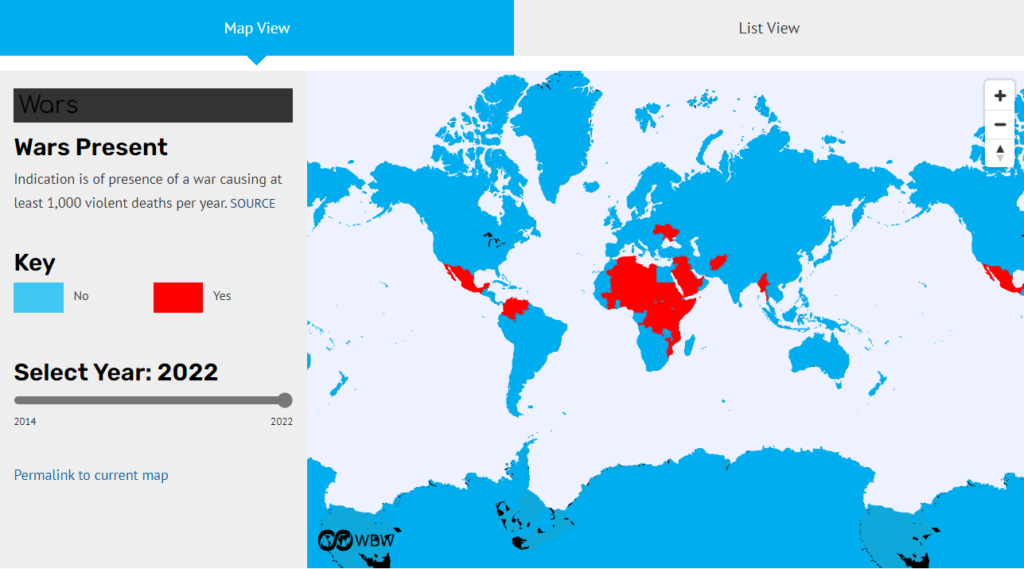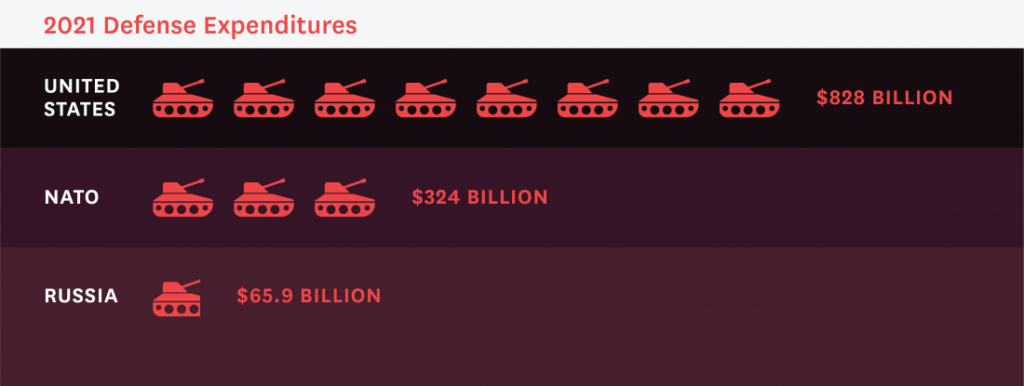The map of where the wars are, disturbingly, shows more wars than ever in 2022 (26 in 2021, 18 in 2020) despite a global disease pandemic and demands for a ceasefire. As always, the map of places where the wars are has hardly any overlap with maps of where the weapons come from.
According to the World BEYOND War’s database of the anti-war global movement World BEYOND War (WBW), military conflict has been present in 36 countries in 2022 (Indication is of presence of a war causing at least 1,000 violent deaths per year).

This useful database contains information on information about current wars, military spending, military “aid,” and peace treaties around the world (including maps and lists). When you visit the Mapping Militarism site, you will find seven sections linked across the top (War, Money, Weapons, Nuclear, Chemical and Biological, U. S. Empire, Promotes Peace and Security), most of which contain multiple maps listed down the lefthand side. Each map’s data can be seen in map view or list view, and the data in list view can be ordered by any column you click on. Most of the maps/lists have data for a number of years, and you can scroll back through the past to see what’s changed. Every map includes a link to the source of the data.
It is a sad testimony to the aggressiveness and militarisation of the world, brought about by the wrong way of dealing with the problems of world security after the collapse of bipolarity, that global military spending has grown despite the economic hardships caused by the pandemic Covid-19. Even the severe economic and social effects of the pandemic have not ended the continuous upward trend in world military expenditure seen since 2015. Global spending in 2021 was 0.7 per cent higher than in 2020 and 12 per cent higher than in 2012. World military expenditure surpassed the two trillion US dollar mark for the first time, reaching $2.1 trillion in 2021.
The US has traditionally been the leader in arms investment; since the Stockholm International Peace Research Institute (SIPRI) began publishing military spending data in the late 1960s, it has had the highest level of military spending of all time. Last year, Washington allocated a record nearly US$801 billion to the sector (according to other sources, as much as US$828 billion – see Figure 2). In 2021 China’s military spending rose for the 27th consecutive year, to reach $293 billion. Russia’s military expenditure grew for the third consecutive year in 2021. Spending rose by 2.9 per cent, to reach $65.9 billion, or 4.1 per cent of gross domestic product (GDP).
According to SIPRI the five largest military spenders in 2021 were Quatar (3955 the United States, China, India, the United Kingdom and Russia, which together accounted for 62 per cent of world military spending. Military spending by the top 15 countries reached $1717 billion in 2021, accounting for 81 per cent of global military expenditure.
When it comes to military spending per capita, Mapping Militarism database shows that the leading spenders in 2021 Qatar ($3,955), followed by Israel ($2,769), the US ($2,405), Kuwait ($2,804) and Singapore ($1,884). Slovakia is 39th in the ranking (USD 363), just behind the Czech Republic (USD 367). For comparison, in 2020, Israel had the highest per capita spending, followed by the US, Saudi Arabia, Singapore, and Kuwait.
“China is now a true peer competitor in the military,” claimed Thomas Friedman on April 28, 2021, in the New York Times. This sort of claim is debunked by the maps on spending and spending per capita, which we’ve created using data from Stockholm International Peace Research Institute (SIPRI). SIPRI leaves out a great deal of U.S. military spending, but is the best set of data available to compare nations with each other. It turns out that China spends 32% what the United States does, and 19% of what U.S. and NATO members/partners do (not including Russia), and 14% of what the United States plus allies, weapons customers, and military “aid” recipients spend together on militarism. In per capita terms, the U.S. government spends $2,170 on war and war preparations for every U.S. man, woman, and child, while China spends $189 per capita.
Another area dominated by the United States is weapons. Not only does the United States export the most weapons, but it exports them to much of the world, and bestows military “aid” on the vast majority of the world, including most of the world’s most brutal governments.
When it comes to the number of nuclear warheads possessed, these maps make clear that two nations dominate all others: the United States and Russia, while the nations about which we have the best knowledge of possessing chemical and/or biological weapons are the United States and China. While the Russian military maintains the world’s largest stockpile of nuclear weaponry, the Russian defense budget amounts to less than 1/10 of the U.S. defense budget, just 1/5 of NATO (non-U.S.) spending, and just 6% of the NATO defense spending on aggregate.
The maps in the section on U.S. Empire include the number of U.S. bases and troops per country, each country’s membership or partnership with NATO, and a global picture of U.S. wars and military interventions since 1945. The United States continues to maintain around 735 military bases abroad in 80 foreign countries and colonies (territories). These bases are costly in a number of ways: financially, politically, socially, and environmentally (loss of land or livelihoods, pollution and health risks caused by conventional or non-conventional weapons testing) are an integral part of preparations for war and undermine international peace and security. These bases serve to proliferate weapons, increase violence and undermine overall international stability.
The Pentagon, since Fiscal Year 2018, has failed to publish its previously annual list of U.S. bases abroad. Global movement World BEYOND War has presented the fullest public accounting of U.S. bases and military outposts worldwide. The lists and map included in the report illustrate the many problems associated with these overseas bases, offering a tool that can help policymakers plan urgently needed base closures.
The set of maps on the promotion of peace and security in the database Mapping Militarism tell a different story. Here we see different patterns, with countries standing out as leaders on the rule of law and peacemaking that are not among the leaders in warmaking on the other maps.
MILITARISM IS A PARADIGM THAT NEEDS TO GO INTO THE DUSTBIN OF HISTORY ALONGSIDE SLAVERY OR CHILD LABOR
Despite record global military spending reaching an all-time high in 2021, surpassing $2.1 trillion for the first time, and a record U.S. military budget surpassing $800 billion, many Members of the U.S. Congress cite the threat posed by Russia as the key reason it must continue to rise.
According to House Armed Services Committee Chairman Adam Smith, “the FY23 budget would be ‘bigger than we thought,’ as Russia’s invasion of Ukraine … complicated the U.S. security posture and impressed a greater sense of urgency for funding defense priorities.”

But in a new study from the Costs of War Project of Watson Institute for International and Public Affairs, military strategy expert Lyle Goldstein offers evidence to the contrary, and lays out the case for why the United States should not engage in threat inflation when it comes to Russia, or use Russia as an excuse to expand the military budget.
1. Russia is a comparably weak military force and there is no cause for fear of a Russian military threat to the United States.
Russia has invested far fewer resources in its conventional military than the United States and views its own military strength as lagging very significantly behind the U.S. Though U.S. military spending has long surpassed Russia’s, it has escalated dramatically in the post-9/11 era. Consider:
- The Russian military budget amounts to less than 1/10 of the U.S. military budget, just one-fifth of non-U.S. NATO spending, and six percent of the NATO defense spending aggregate.
- The U.S. Navy has more than 10 times the number of aircraft carriers as Russia, more than 5 times the number of large surface combatants, and more than double the number of amphibious attack ships and nuclear submarines.
- Russia has just 37% of the total U.S. combat aircraft.
Russia’s comparative military weakness is on display in its war in Ukraine, in stark contrast to what many predicted pre-invasion. The reality is that Europe can and should take its security into its own hands, freeing the United States to trim its own military budget.
2. An increase in military spending and conventional forces in Europe from the United States and NATO could paradoxically prompt Russia to rely more heavily on its nuclear forces.
Russia has invested heavily in nuclear weapons as opposed to its comparatively weaker investment in conventional forces. It holds the world’s largest stockpile of nuclear weaponry. An unclassified report from the Naval War College predicts “Moscow is unlikely to use nuclear weapons … unless the Putin regime judged that an impending defeat during conflict would undercut the government’s legitimacy and create an existential threat via domestic upheaval (through loss of territorial integrity or other pivotal wartime event).”
Rather than meeting Russia’s buildup with a U.S. buildup and fostering a new arms race, a far more effective way to remain secure would be to reinvigorate arms control negotiations.
3. Historically, threat inflation has led to disastrous and unnecessarily costly U.S. foreign policy decisions.
For example, the famous “missile gap” in the late 50s and early 60s turned out to be completely backwards – even though politicians convinced themselves that the Soviet Union had hundreds of ICBMs and that the United States needed to catch up, the National Intelligence Estimate of September 1961 revealed that the Soviet Union had only 10 to 25 missiles at the time, far fewer than the more than 100 U.S. land- and sea-based missiles prepositioned in foreign countries and on submarines. Such threat inflation persisted over the course of the Cold War, and resulted in the United States spending more than $10 trillion in 2022 dollars on nuclear weaponry. These mistakes should not be repeated.
WE MUST FIND A PATH TO A JUST AND SUSTAINABLE PEACE
All people of all nations face three existential threats today:
- Climate change has resulted in more frequent and more intense storms, floods, droughts, fires, and killer heatwaves. Each day brings us closer to global tipping points that will accelerate the adverse effects on humans and all species.
- Pandemics: the COVID pandemic has taken more than a million lives in the US and 6.5 million worldwide. Experts say that future pandemics will come at increased frequency. Pandemics are no longer Hundred Year events and we must act accordingly.
- Nuclear annihilation: At one time, war was limited to the battlefield. It is now estimated that a full nuclear exchange between the US and Russia will kill some five billion humans. Even a smaller war between Indian and Pakistan could result in two billion dead. According to the Bulletin of Atomic Scientists, the Doomsday Clock is the closest to midnight since its creation some 70 years ago.
The only way we can solve the threats we face is together as an international community. These threats are relatively new in the 200,000 years of humanity. Therefore, new solutions are needed.
September 21st was designated by the United Nations as International Day of Peace. Despite poor media coverage, we in the United for Peace association honored this day with a Peace March Peace First! with the participation of celebrities who called on politicians for a diplomatic solution to the war in Ukraine. You could not be blamed for missing it in Slovakia or elsewhere as the mainstream media and politicians have traditionally ignored this holiday and all the news focused on the war. But we desperately need to move beyond a symbolic day for peace to a just and sustainable peace. We have to find a way to end the wars in Europe, the Middle East, and Africa. This can only be done through diplomacy.
The high costs of militarism have always been terrible; now they are prohibitive. Invoking the classic statement ‘if you want peace, prepare for war’, in the current environment causing huge profits for arms companies and arms dealers. Massive fiscal outlays to even just prepare for war enrich the profiteers and impoverish everyone else and leave little for real human needs. The carbon footprint and toxic legacies of militaries of the world are overwhelming the planet and all of life, with the US military in particular the largest single consumer of petroleum products on Earth.
Anyone can see that what we are doing is not sustainable and will ultimately lead to a vast increase in human suffering. We face a bleak future if we continue on this path. Now is the time to change course.
The only way we can create an international community is to build trust. The only way we can build trust is to address the security concerns of all nations. The only way to address the security concerns of all nations is through strong international organizations, verifiable international treaties, de-escalation of tensions, de-militarization, elimination of nuclear weapons, and relentless diplomacy.
There is no single path to peace, but all pro-peace initiatives need to be welcomed without exception. The peaceful coexistence of European states and peoples should have been the first great phase on the road to world peace in the past. In the current economic order, it is indeed difficult to imagine a lasting and sustainable peace, but in the current militarism with its code of violence, even a just economic order will not come about. If one waits for the other, nothing will succeed.
It is necessary to overcome the hatred, the mutual hostility that precedes and follows war and that has become something permanent in recent years. We need to understand the truth in Dr. King’s words, “We will either learn to live together as brothers and sisters or perish together as fools.”
War is an obstacle to cultural development and is harmful and despicable from every point of view – moral, economic, religious and philosophical. The struggle for peace is a universally human cause that must be pursued equally by women and men. “The day will come when women will no longer admire war heroes, but heroes of peace who are incomparably more significant,” said the pacifist Bertha von Suttner in 1904. Even militarists recognised that it was necessary to admire the courage of this woman who, in spite of all the slandering and ridicule, maintained her ideal of world peace, upholding it in an age that made a mockery of peace, and in a country such as Germany, where the army played such a big role.

Reason must rebel against war and militarism, but let us not therefore suppress the indignation in our hearts either. No war must in any way shake confidence in the peace movement, for peace is the supreme concern of our time, and everything that serves the cause of peace transcends all personal considerations.
Author: Mgr. Iveta Kompišová, PhD., Chair of the Management Board, United for Peace




